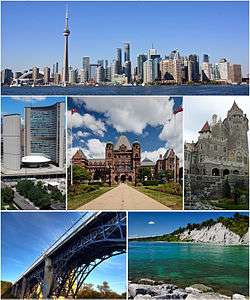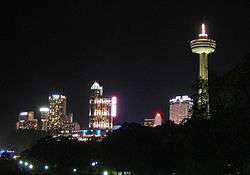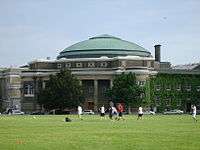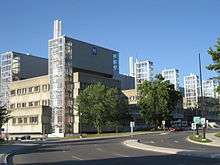Golden Horseshoe
| The Golden Horseshoe | |
|---|---|
| Secondary region | |
 Location of the Golden Horseshoe in Ontario. ██ Core area ██ Extended area | |
| Coordinates: 43°36′N 79°44′W / 43.6°N 79.73°WCoordinates: 43°36′N 79°44′W / 43.6°N 79.73°W | |
| Country |
|
| Province |
|
| Area | |
| • Total | 31,561.57 km2 (12,185.99 sq mi) |
| • Extended area | 21,464.12 km2 (8,287.34 sq mi) |
| • Core area | 10,097.45 km2 (3,898.65 sq mi) |
| Population (2011) | |
| • Total | 8,759,312 |
| • Density | 277.53/km2 (718.8/sq mi) |
| • Extended area | 1,753,826 |
| • Core area | 7,005,486 |
| Time zone | EST (UTC−5) |
| • Summer (DST) | EDT (UTC−4) |
| Postal code prefixes | K, L, M, N |
| Area code(s) | 226, 249, 289, 365, 416, 437, 519, 647, 705, 905 |


The Golden Horseshoe is a region of Southern Ontario, Canada, which lies at the western end of Lake Ontario with outer boundaries stretching south to Lake Erie and north to Georgian Bay. The region is among the most densely populated and industrialized in Canada. Most of it is also part of the Greater Toronto and Hamilton Area, Quebec City–Windsor Corridor and the Great Lakes Megalopolis. With a population of 8.76 million people in 2011, the Golden Horseshoe makes up over 26% of the population of Canada and contains more than 68% of Ontario's population,[1] making it one of the largest population concentrations in North America. The area has a greater population than the entire province of Quebec or the three prairie provinces combined. Although it is a geographically named secondary region of Southern Ontario, the Greater Golden Horseshoe is also used today to describe a broader region that stretches from the area of the Trent–Severn Waterway to at least the Grand River area, including centres outside of the core region.
The core of the region starts from Niagara Falls at the eastern end of the Niagara Peninsula and extends west, wrapping around the western end of Lake Ontario at Hamilton and then turning northeast to its anchor city Toronto (on the northwestern shore of Lake Ontario), before finally terminating at Oshawa, just east of Toronto. The wider region spreads inland in all directions away from the Lake Ontario shoreline, southwest to Brantford, west to the Waterloo Region area, north to Barrie, and northeast to Peterborough. The whole region's area covers approximately 33,500 km2 (13,000 sq mi), out of this, 7,300 km2 (2,800 sq mi) or approximately 22% of the area is covered by the environmentally protected Greenbelt.
Definition
The Golden Horseshoe has been recognised as a geographic region since the 1950s, but it was only on July 13, 2004 that a report from the provincial Ministry of Public Infrastructure Renewal entitled Places to Grow coined the term Greater Golden Horseshoe, extending the boundaries west to Waterloo Region, north to Barrie/Simcoe County, and northeast to the county and city of Peterborough.[2] A subsequent edition released February 16, 2005, broadened the term further, adding Brant, Haldimand and Northumberland Counties to the now quasi-administrative region. The Greater Golden Horseshoe region is officially designated in Ontario Regulation 416/05[3] under the Places to Grow Act.
Nearly all the cities and counties added to the extended region straddle the Grand River to the west and the Trent/Severn river and canal system to the north and east; both being waterways that appear to play a role in defining the region geographically. Statistics Canada defined the expanded region first in its 2001 census as the Extended Golden Horseshoe, combining many Census Metropolitan Areas, but excluding areas of the provincially defined region that are still mostly rural in nature.
Demographics
The population of the Greater Golden Horseshoe was 8.7 million residents at the 2011 census.[1]
The region is projected to grow to 11.5 million people by 2031.[4] The definition of the Golden Horseshoe as an agglomerated urban area, that is combining Census Metropolitan Areas is similar to how population counts are tabulated for Combined statistical area, which are used in the USA to combine more than one metropolitan area, defined as an MSA (Metropolitan Statistical Area), into a larger overall urbanized area. These metropolitan areas are intrinsically linked through inter-dependence of services, trade, transportation corridors, close proximity and other factors, in this context they can also be viewed as a single region. In 2011, the Greater Horseshoe was the fifth most populous greater urbanized area in North America, just behind the Baltimore-DC-Northern Virginia CSA.
Economy
The economy of this region is very diverse. The Toronto Stock Exchange is the third largest in North America by market capitalization (after the New York Stock Exchange and NASDAQ), and seventh largest in the world.[5]
Niagara Falls has one of the world's largest per-capita tourist economies, benefiting from millions of tourists coming to see its majestic waterfalls, shop in its numerous stores, and visit its many attractions. The wine making and fruit growing industries of the Niagara Peninsula produce award-winning wines which are beginning to attract attention around the world, in particular the ice wine for which the region is known.
Cities such as Hamilton, Oshawa, Oakville, Whitby and Kitchener all contain major large-scale industrial production facilities, Hamilton being steel-dominated and Oshawa being much more car-oriented. Other significant automotive-production facilities also exist in Brampton, St. Catharines, Cambridge and Alliston. Hamilton and Toronto also have two of the largest seaports in Lake Ontario. The Welland Canal system handles tanker ship and recreational traffic through the Great Lakes. Large rail and truck distribution facilities are located in Toronto, Vaughan and Brampton. Food processing is also a key ingredient in the economy. While manufacturing remains important to the economy of the region, the manufacturing sector has experienced a significant decline since 2000 as a result of unfavourable currency exchange rates, increasing energy costs, and reduced demand from the USA, which is by far the largest market for Ontario's goods.
As of 2014, sectors such as IT, health care, tourism, research and finance provide the bulk of growth. The suburban cities of Brampton, Markham and Mississauga are emerging as technology hubs.
Name
The "horseshoe" part of the region's name is derived from the characteristic horseshoe shape of the west end of Lake Ontario with Cootes Paradise between Burlington and Hamilton roughly positioned in the centre. The "golden" part is historically attributed to the region's wealth and prosperity, according to the Canadian Oxford Dictionary.
The full phrase, "Golden Horseshoe," was first used by Westinghouse president Herbert H. Rogge in a speech to the Hamilton Chamber of Commerce, on January 12, 1954:
Hamilton in 50 years will be the forward cleat in a 'golden horseshoe' of industrial development from Oshawa to the Niagara River...150 miles long and 50 miles (80 km) wide...It will run from Niagara Falls on the south to about Oshawa on the north and take in numerous cities and towns already there, including Hamilton and Toronto.— [6]
The speech writer who actually penned the phrase was Charles Hunter MacBain, executive assistant to five Westinghouse presidents including Rogge.[7]
Attractions

Toronto is an alpha global city, known for its performing arts and night life. Downtown Toronto is one of the largest downtowns in North America. The city is pedestrian friendly and has one of the lowest crime rates in Canada; the 45 murders committed in 2011 is the lowest for a major North American city.[8]
Toronto's Yorkville is an example of a world-class shopping district in the city. The city also is home to several notable shopping malls such as Yorkdale Shopping Centre, Toronto Eaton Centre, Scarborough Town Centre, and Sherway Gardens. Located in the suburbs of Toronto are Vaughan Mills in Vaughan, Bramalea City Centre in Brampton and Square One Shopping Centre in Mississauga, the largest suburban shopping mall in Ontario. Pacific Mall, in Markham, is the largest ethnic shopping mall in eastern Canada.
Large annual cultural festivals that draw tourists and local alike include Oktoberfest in Kitchener and the Scotiabank Caribbean Carnival (formerly known as Caribana) in Toronto.
The Niagara Region has become one of the major wine-production areas in Canada. The Golden Horseshoe contains many small towns with tourist-jammed, historic main streets, most notably the community of Niagara-on-the-Lake, located at the mouth of the Niagara River. Niagara Falls is one of the world's largest waterfalls, and attracts millions to Clifton Hill, a neighbourhood featuring hundreds of amusements, souvenir stores, restaurants and skyline-changing hotels. Casinos here are also a huge draw.
The Niagara Escarpment, a world biosphere as designated by the United Nations, runs from the north at Bruce Peninsula and then east through the region cutting the Niagara Gorge at Niagara Falls. The Bruce Trail runs along the escarpment through mostly protected woodlands. The Cheltenham Badlands in Caledon is an environmentally degraded area along the Niagara Escarpment. Similar protection of some wooded areas exists on the Oak Ridges Moraine running east-west in the north end of the Greater Toronto Area, although development pressures continue to threaten the natural habitat.
Hamilton has the historical reputation of being a blue-collar city; however, waterfront redevelopments and large-scale gentrification have been rapidly changing the perception of the city, although it retains a dominant industrial base. Barrie and Peterborough are situated close to scenic lakes, rivers and hills in the northern reaches of the Golden Horseshoe, where all-year around recreation contributes to the local economies, in addition to being major service centres.
There are a number of theme parks in the Golden Horseshoe, all of which are seasonal. Canada's Wonderland, run by Cedar Fair in Vaughan, 2 km (1.2 mi) north of Vaughan Mills, is the largest and most attended theme park in Canada. Other theme parks include Wild Water Kingdom in Brampton, African Lion Safari in Flamborough (part of Hamilton, though geographically closer to Cambridge), and Marineland in Niagara Falls. Though not a theme park per se, the Exhibition Place hosts the annual Canadian National Exhibition.
Sports
The Golden Horseshoe is home to many professional sports teams, most of which are Toronto-based. These teams include:
- Brampton Thunder (ice hockey)
- Brampton Beast (ice hockey)
- Hamilton Tiger-Cats (Canadian football)
- K-W United FC (soccer)
- Orangeville A's (basketball)
- Raptors 905 (basketball)
- Toronto Argonauts (Canadian football)
- Toronto Blue Jays (baseball)
- Toronto FC (soccer)
- Toronto Furies (ice hockey)
- Toronto Lady Lynx (soccer)
- Toronto Maple Leafs (ice hockey)
- Toronto Marlies (ice hockey)
- Toronto Raptors (basketball)
- Toronto Rock (indoor lacrosse)
The Golden Horseshoe hosted the 2015 Pan American Games and the 2015 Parapan American Games.
Education


The Golden Horseshoe is home to several universities, many of which are well known and respected throughout the world, including the University of Toronto and McMaster University in Hamilton, which are ranked 1st and 4th in Canada, respectively, by the Academic Ranking of World Universities. Other universities in the region include Brock University, University of Guelph, University of Waterloo, Wilfrid Laurier University, Trent University, York University, OCAD University, Georgian College, University of Ontario Institute of Technology, and Ryerson University.
There is also a strong integration between the universities and hospitals in the area, particularly in Toronto and Hamilton. Both cities have an extensive medical research core.
Transportation
The Golden Horseshoe is served by an extensive network of expressways, the backbone of which is Highway 401, one of the widest and busiest expressways in the world. Regional transit is provided by GO Transit trains and buses, and by private bus operators Greyhound and Coach Canada. Local transit is provided by municipal agencies, the largest of which is the Toronto Transit Commission, which operates three subway lines and one light metro line and an extensive bus and streetcar network. Several cities in the region have approved rapid transit lines and would be beginning construction by 2014,[10][11] these include the Ion light-rail system in Kitchener-Waterloo and the Hurontario LRT in Mississauga and Brampton. Toronto is currently the only city in the area with a rail-based local rapid transit network and is planning on a major expansion within the decade.
The primary airport of the region is Toronto Pearson International Airport (officially Lester B. Pearson International Airport), located in Mississauga, which is the busiest in Canada and the 33rd busiest in the world, handling over 41 million passengers in 2015, and offering non-stop flights worldwide. Other regional airports of significance include John C. Munro Hamilton International Airport located in southern Hamilton, which is a major regional freight and courier location; Buttonville Airport and Billy Bishop airport in the Greater Toronto Area, both of which mostly serve regional business travellers but the latter being the third largest in the region for passenger volume. Within driving distance are Region of Waterloo International Airport just east of Kitchener, serving the Region of Waterloo and Buffalo Niagara International Airport, near Niagara Falls, New York, in the U.S. Buffalo Niagara carries the second largest passenger volume in the region, serving 5.5 million passengers in 2008. It is frequently used by Canadian passengers flying to U.S. destinations.
Divisions
Census Metropolitan Areas
Population figures are from the 2011 census.
Golden Horseshoe CMAs
|
Greater Golden Horseshoe CMAs |
Municipalities
References
- 1 2 "Portrait of the Canadian Population in 2006: Subprovincial population dynamics, Greater Golden Horseshoe". Statistics Canada, 2006 Census of Population. 2007-03-13. Retrieved 2007-03-13.
- ↑ "Places to Grow". Archived from the original on 2006-09-07. Retrieved 2006-09-13.
- ↑ Ontario Statutes and Regulations
- ↑ Greater Golden Horseshoe, GTA and Hamilton Population, Household and Employment Forecasts
- ↑ 2 Ontario
- ↑ "Fast Facts from Hamilton's Past". Retrieved 2007-01-08.
- ↑ http://www.bizmagazine.ca/sitepages/?aid=3623&cn=LOOKING%20BACK&an=The%20Golden%20Truth%20%7C%20Q1%202011
- ↑ Toronto 26th most dangerous city in Canada: report, CTV News, March 13, 2008
- ↑ "McMaster University Website". Retrieved 2007-06-26.
- ↑ Outhit, Jeff (Oct 27, 2011). "Rail yard purchased for rapid transit". Waterloo Region Record. Retrieved 2012-04-08.
- ↑ "Hurontario/Main Street Corridor Master Plan" (PDF). MMM Group. October 2010. p. 578. Retrieved 2012-04-08.
External links
 Golden Horseshoe travel guide from Wikivoyage
Golden Horseshoe travel guide from Wikivoyage
